Risshakuji - Yamadera's Intriguing Mountain Temple

Risshakuji Temple, built twelve centuries ago up a steep riverside cliff in Yamagata prefecture, has a rich history. Its scenic setting make it one of the top destinations in Tohoku!
Yamagata, an important agricultural prefecture in the Tohoku region, is home to one of the most interesting temples in Japan. This is the Risshakuji Temple complex at Yamadera, where Yakushi Nyorai, the Buddha of healing and medicine, is enshrined.
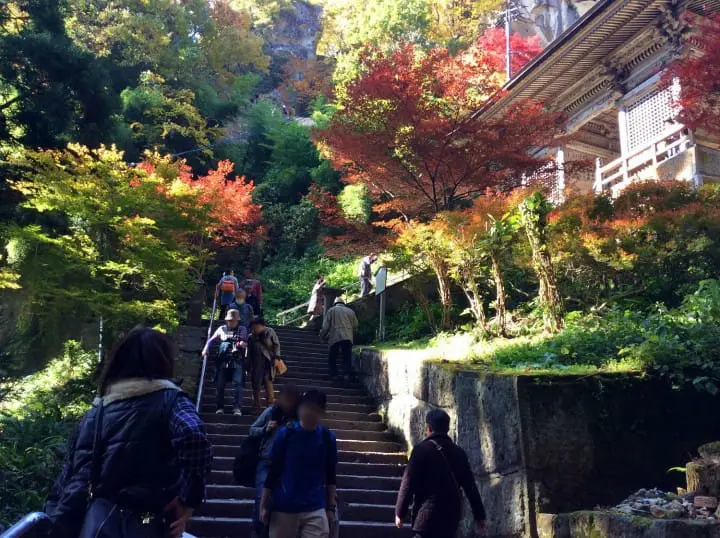
This intriguing Yama-dera "mountain temple" clings to the hillside in a gorgeous location above a river valley. It is a nationally designated place of scenic beauty and listed as a historic site.
Although built in 860 AD, over the centuries it has been destroyed more than once, and the current temple dates from the 16th century by which time it had become a rich and important religious center of the Tendai sect of Buddhism. It is a Tendai pilgrimage site, along with three other temples in Tohoku: Zuiganji in Matsushima (Miyagi prefecture), and Chusonji and Motsuji, both in Hiraizumi (Iwate prefecture).
Read also:
The temple was founded in the 9th century, and the story endures that the flame burning in the main Konponchudo Hall was brought live from the main Enryakuji Temple in Kyoto and it has therefore been burning for over a thousand years.
Ennin - The Founder of Risshakuji Temple
The Emperor Seiwa (794 - 1185 AD) is said to have ordered Ennin to establish Tendai sect temples in what was then called Dewa Province (the area corresponding to Yamagata and Akita prefectures), along the northern borders of the Japan then under control from Kyoto.

Ennin (794-864 AD, posthumously called Jikaku Daishi) had traveled in China for several years and on returning was instrumental in helping to spread Tendai Buddhism in Japan. He brought back sutras, mandalas, ritual implements, sketches and images to help Japanese monks give form to their studies. The diary of his China travels held at the Toji Temple in Kyoto is a classified National Treasure in Japan and the eminent scholar and former U.S. Ambassador, Edwin O. Reischauer, who translated Ennin’s "Record of a Pilgrimage to China in Search of the Law," made a visit to Yamadera in 1965.
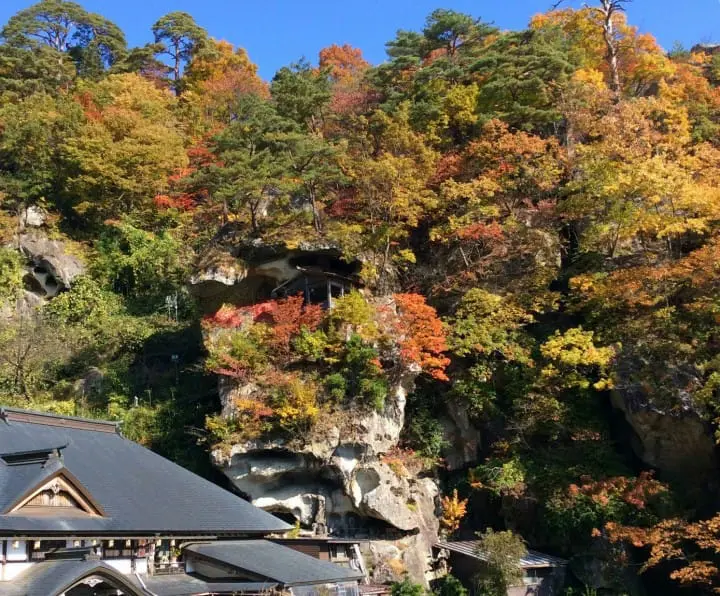
Establishing mountains as sacred spaces through imported Buddhism fit naturally with indigenous Japanese traditions venerating mountains and nature. There is evidence of human habitation in this village even before Jomon times (Neolithic period) and the site is thought to have been important long ago as a place for animistic rituals. The geological formations are dramatic and unusually gigantic boulders caused Yamadera to be seen as a special place even in prehistoric times.
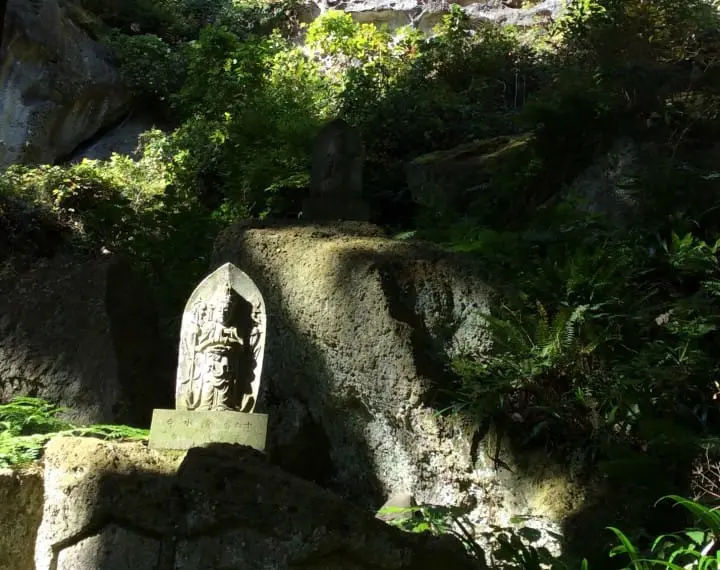
Mountains are traditional homes to deities, and branching off the path up the cliff face are about thirty small temples and shrines perched on outcrops in the rock. There are also many small caves and geological openings under rocks where mountain ascetics chose minimally austere conditions to live and study an esoteric Buddhism.
Over one thousand years ago, Yamadera was a place of jikyuu jisoku (self-sufficiency), where monks had to manage their food by picking mountain vegetables and farming. This self-sufficiency was the antithesis of our comfortable modern lives with convenience stores and digital access to anything and everything. Prioritizing the spiritual is somewhat counter-cultural in our comfort-oriented society and these days urbanized people sometimes go to great effort and expense to experience rigors and austerity in special training programs and extreme sports in order to be reminded of their own power.
Visit Yamadera Any Time of the Year
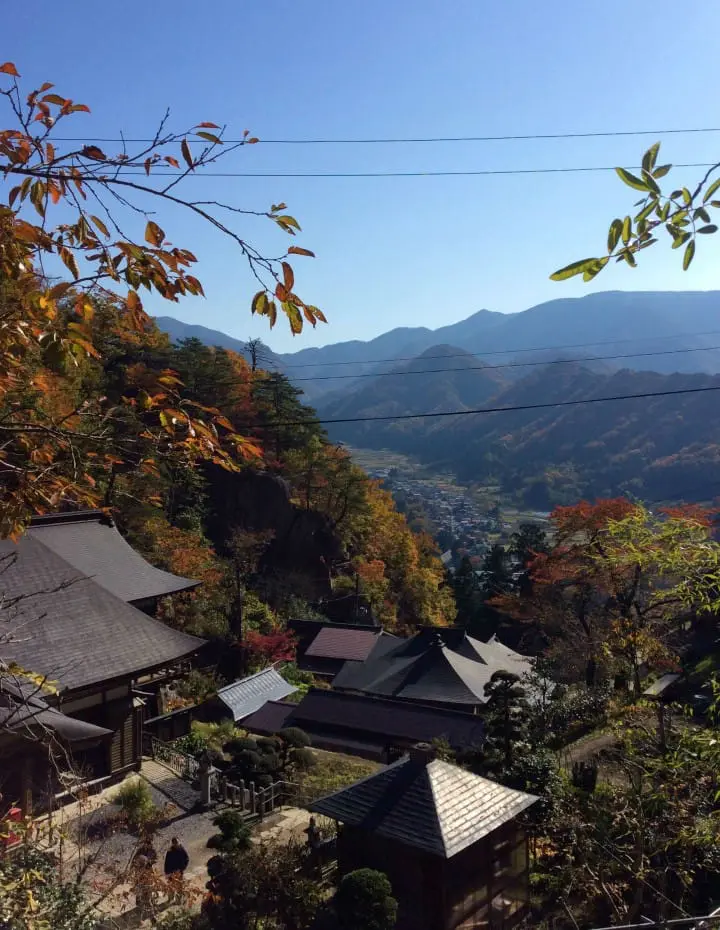
As the name implies, you have to be ready for a rather steep 30-minute climb up about 1,000 steps. All seasons have their appeal! In spring, of course, there are cherry trees in blossom. During the summer (6:00 pm - 9:00 pm), the path is illuminated for evening Buddhist chants and ceremonies. Formerly, people used to climb up during the day, spend the night at the temple and come down the following morning. A hike through the snow on a sunny winter day is gorgeous. Daytime temperatures are usually above freezing, however, because of snow and ice that could be dangerously slippery, good boots are recommended. The autumn is beautifully colored since the rock face is forested with the natural deciduous tree cover that turns orange, gold and red in the autumn sun.
Yamadera and Matsuo Basho
Matsuo Basho altered his planned itinerary to ride to Yamadera and wrote a famous haiku on the piercing sound of cicadas drilling into the peaceful stillness of the area.
Shizukesa-ya / iwa ni shimiiru / semi no koe.
-
Surrounding quiet,
Vibration of cicadas
Penetrates the boulders.
Across the river, the Basho Memorial Museum, or Yamadera Bashō Kinenkan (entrance: 400 yen), commemorates Basho’s work and his visit to Yamadera. Aside from information related to Basho, there are changing exhibits on literary themes, haiku contests (feel welcome to sign up for an English haiku contest held in July) and tea ceremonies. An interesting feature of the tea ceremony room is the suikinkutsu, a water echo cistern. Unfortunately this is not used during the winter months.
Also, on the other side of the valley, is the delightful Goto Museum of Art, unexpectedly full of 17th-19th century European paintings and Tiffany glass objects. (Entrance: 800 yen)
Soba and Konnyaku, Yamagata's Specialties
Yamagata is famous for soba and there are several soba restaurants in Yamadera. Among them, Masuya is one that also has a small fish pond where you can catch your own masu and the owners will grill it right away for your lunch!
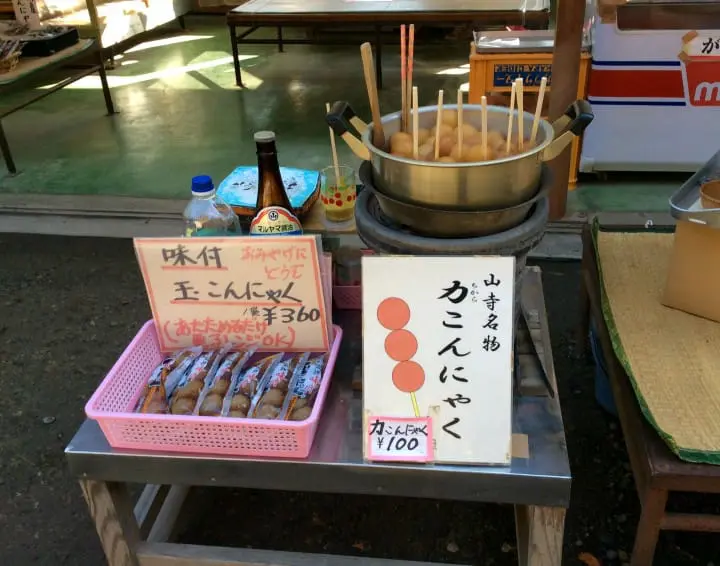
Tama konnyaku at Yamadera
Konnyaku is a common food in Japan. However, tama konnyaku (tama-kon) is particularly popular in Yamagata. There are several stands selling it around the entrance to Yamadera. Three or four ping pong sized konnyaku balls simmered in soy broth are speared on a disposable chop stick and eaten with a little mustard. It is tasty, and also considered healthy since it has few calories but is high in fiber and so has a beneficial effect on the intestines.
Access to Yamadera
Yamadera Station is on the JR Senzan train line so it is easy to get there by train from either Sendai or Yamagata City. The Yamagata Airport is only about 15 kilometers, or a half-hour ride, from Yamadera.
There is something different in the sense of time at Yamadera. Since it is not only man-made, but partly carved out of the rocks, Risshakuji seems to exist on geological time.
Certainly worth a detour any time of the year, especially on a sunny day!
English teacher and editor/proofreader living in Tohoku.







































![[Coupon Available] Attention Overseas Winter Sports Fans! Nagano's Sports Depot Has Evolved](https://resources.matcha-jp.com/resize/720x2000/2026/01/05-254819.webp)
![[2 hours from Tokyo ] 10 Quiet and Breathtaking Views of Mount Fuji in Yamanashi Hokuto City , Yamanashi - Part 2](https://resources.matcha-jp.com/resize/720x2000/2025/12/16-253037.webp)

![[Reopening in March 2026] Ikoma Sanjo Amusement Park Park, 45 minutes from Osaka , with free admission](https://resources.matcha-jp.com/resize/720x2000/2024/08/28-194409.webp)